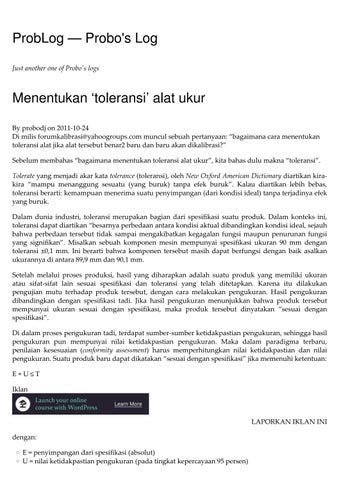
In every measurement process, understanding tolerances is crucial. To clarify, toleransi perbedaan nilai hasil pengukuran akibat keterbatasan alat ukur refers to the acceptable variations in results due to the limitations of measuring instruments. These limitations often lead to discrepancies that can impact data interpretation and decision-making.
By acknowledging these tolerances, we can better navigate the complexities of measurement and enhance the accuracy of our findings. This article delves into why recognizing this tolerance is essential for reliable results in various fields, from science to engineering.
Jelaskan Toleransi Perbedaan Nilai Hasil Pengukuran Akibat Keterbatasan Alat Ukur
In the world of measurement, accuracy is crucial. However, every measurement tool has its limitations, which can lead to discrepancies in the results obtained. Understanding tolerance for differences in measurement values due to the limitations of measuring instruments is essential for anyone involved in scientific research, engineering, or any field that relies on precise measurements. This article delves into the concept of measurement tolerance, its significance, and how to address the challenges posed by instrument limitations.
Understanding Measurement Tolerance
Measurement tolerance refers to the permissible limit or range of variation in a measurement value. When we perform measurements, we often do not receive an exact figure. Instead, we obtain a value that falls within a specific range. This range is influenced by several factors, including:
- The precision of the measuring instrument
- The skill and experience of the operator
- Environmental conditions during measurement
- Calibration of the instrument
Let’s break these factors down further:
The Precision of the Measuring Instrument
Precision speaks to how finely an instrument can measure. Instruments with high precision can yield results with minimal deviation from the true value. For example, a digital caliper can measure to the nearest millimeter or even smaller, while a traditional ruler might only measure to the nearest centimeter. The more precise the instrument, the smaller the tolerance range, allowing for more reliable data.
The Skill and Experience of the Operator
The operator’s knowledge and skill can greatly impact measurement results. An experienced technician will understand how to use the tool properly, recognize limitations, and adjust accordingly. Conversely, a novice might misinterpret readings or use the instrument incorrectly, leading to larger discrepancies.
Environmental Conditions
Environmental factors such as temperature, humidity, and pressure can affect measurements. For instance, a thermometer’s reading can vary based on the ambient temperature. If the instrument is not designed to operate under varying conditions, it might yield incorrect values.
Calibration
Regular calibration ensures that measuring instruments provide accurate results. Over time, instruments can drift out of calibration due to wear and tear or environmental influences. It’s essential to periodically check and recalibrate instruments to maintain their accuracy and reliability.
Types of Measurement Errors
Measurement errors can be classified into two main categories: systematic errors and random errors.
Systematic Errors
These errors are consistent and repeatable inaccuracies that occur due to issues with the measuring instrument or methodology. Common causes of systematic errors include:
- Miscalibrated instruments
- Improper measurement techniques
- External influences, such as electromagnetic interference
Systematic errors can often be identified and corrected, making them predictable.
Random Errors
Unlike systematic errors, random errors arise from unpredictable fluctuations in the measurement process. These are caused by:
- Minor variations in the environment (e.g., temperature shifts)
- Human error during measurement
- Instrument limitations that vary with each use
Random errors can be more challenging to address, but understanding their nature can help minimize their impact through repeated measurements and statistical analysis.
Establishing Tolerance Levels
To effectively manage discrepancies in measurement results, establishing tolerance levels is crucial. Tolerance levels serve as benchmarks that help assess the acceptability of measurement variations. These levels are determined by:
- Industry standards: Different fields have specific standards that dictate acceptable tolerances.
- Application requirements: Depending on how the measurement will be used, tolerances may vary. For example, in medical devices, even minor variations can be critical.
- Instrument capabilities: Understanding the limits of the measuring instrument helps set realistic tolerances.
By analyzing these factors, one can establish appropriate tolerance ranges that balance accuracy and practical application.
Practical Applications of Tolerance in Measurement
Understanding and applying tolerance in measurements has significant implications across various fields. Here are a few practical applications:
Engineering and Manufacturing
In engineering and manufacturing, tolerance levels dictate how parts fit together. If components do not meet specified tolerances, they may not function properly or safely. Designers use tolerance specifications to ensure consistency and reliability in products.
Quality Control
In quality control processes, tolerance levels help determine whether products meet required standards. If a manufactured item falls outside of these tolerances, it may be deemed defective or require rework.
Scientific Research
In research, establishing measurement tolerances allows scientists to understand the reliability and validity of their data. It can affect the interpretation of results and their applicability in real-world scenarios.
Addressing Limitations of Measuring Instruments
Recognizing the limitations of measuring instruments is crucial for obtaining credible results. Here are strategies to mitigate these limitations:
Regular Calibration
Regular calibration ensures the accuracy of tools. Implement a rigorous schedule for calibration based on how frequently tools are used.
Training and Education
Investing in the training of personnel to use measurement instruments correctly can improve accuracy. Well-trained operators will understand how to minimize errors and adhere to tolerance levels.
Using Multiple Instruments
Employing multiple measuring devices can help cross-verify results. By comparing results from different instruments, one can identify discrepancies and increase confidence in the data.
Data Analysis Techniques
Embrace statistical methods to analyze measurement data. Using techniques such as averages, standard deviations, and control charts can help understand the distribution of results and account for variability.
Case Studies: Real-World Implications of Measurement Tolerance
To illustrate the importance of understanding measurement tolerances, let’s examine two case studies from different industries.
Case Study 1: Aerospace Engineering
In aerospace engineering, precision is critical. A small error in measurement can lead to serious consequences. For instance, the design of a jet engine requires precise measurements to ensure components fit correctly.
When engineers establish tolerance levels for each component, they consider the potential impact of variations. If a part is manufactured just outside its tolerance, it could lead to increased wear or failure during operation. This case shows how rigorous adherence to measurement tolerances can prevent catastrophic failures.
Case Study 2: Pharmaceutical Manufacturing
In pharmaceutical manufacturing, measurement accuracy is essential for ensuring drug safety and efficacy. Each ingredient must be weighed precisely, and variations can lead to ineffective or dangerous products.
Regulatory agencies set strict tolerances for measurements in drug development and manufacturing. Companies must adhere to these tolerances to pass inspections. Failure to do so can result in product recalls, financial losses, and compromised patient safety.
Conclusion: The Importance of Measurement Tolerance
In conclusion, understanding tolerance for differences in measurement values is essential for ensuring reliability and accuracy across various fields. By acknowledging the limitations of measuring instruments, setting realistic tolerance levels, and employing best practices, professionals can enhance the quality of their measurements.
Whether in manufacturing, quality control, or scientific research, establishing a solid foundation of measurement tolerance helps uphold standards and yield trustworthy results. As technology advances and the demand for precision increases, the significance of measurement tolerance will continue to grow, making it an area of focus for anyone involved in technical fields.
Materi Kuliah Metrologi 27102020 Tentang Sifat Umum Alat Ukur
Frequently Asked Questions
What factors contribute to measurement uncertainty in instruments?
Measurement uncertainty arises from various factors including the quality of the measuring instrument, the environment in which measurements are taken, and the skill of the operator. Calibration errors, instrument resolution, and external conditions like temperature or humidity can all affect the accuracy of the results. Understanding these factors helps in evaluating the reliability of measurements.
How can one minimize measurement errors when using instruments?
To minimize measurement errors, users should ensure that the measuring instruments are properly calibrated and maintained. Regular checks and calibrations contribute to greater accuracy. Additionally, using the instruments according to the manufacturer’s guidelines, taking multiple measurements, and averaging the results can help reduce random errors and improve reliability.
What role does resolution play in measurement accuracy?
Resolution refers to the smallest increment that a measuring instrument can detect. A higher resolution allows for more precise measurements, while a lower resolution can introduce significant uncertainty. Understanding the resolution of an instrument helps in assessing its limitations and the reliability of the measurements it produces.
How do environmental conditions affect measurement results?
Environmental conditions such as temperature, humidity, and air pressure can influence the performance of measuring instruments. For example, temperature variations can affect the physical properties of the material being measured or the instrument itself. By controlling environmental factors and using instruments designed for specific conditions, one can enhance the accuracy of measurements.
Can measurement tolerances vary for different applications?
Yes, measurement tolerances can vary significantly depending on the application. Industries like aerospace or medical fields often require stricter tolerances due to the critical nature of their measurements. Conversely, less sensitive applications may allow for wider tolerances. Understanding the specific requirements of each application helps in determining the acceptable limits for measurement discrepancies.
Final Thoughts
Toleransi perbedaan nilai hasil pengukuran akibat keterbatasan alat ukur sangat penting dalam berbagai bidang. Alat ukur yang berbeda memiliki tingkat ketelitian yang berbeda, sehingga hasil pengukuran bisa bervariasi. Memahami dan menjelaskan toleransi perbedaan nilai hasil pengukuran akibat keterbatasan alat ukur membantu dalam menentukan validitas data yang diperoleh.
Dengan menetapkan batas toleransi, pengguna dapat lebih percaya diri dalam hasil yang diambil. Hal ini juga memungkinkan perbandingan yang lebih adil antara data yang dihasilkan dari alat yang berbeda. Sebagai hasilnya, pengukuran yang konsisten dan akurat menjadi lebih mungkin dicapai.




